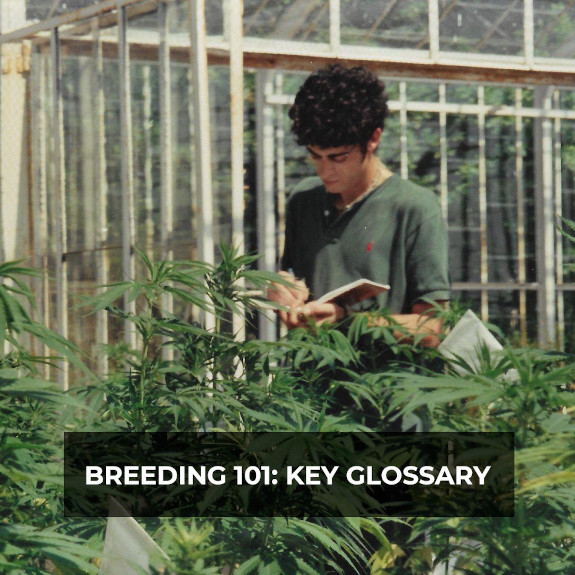Your cart is currently empty!
Breeding 101: Key Glossary
—
article in Breeding Tips

Today, we want to dive into the basics of the breeding glossary as this knowledge guides you through the vast landscape of possibilities. These terms form the foundation upon which breeders, growers, and enthusiasts communicate.
As part of the «Be a Breeder» line, we’ve prepared a series of articles about breeding to help you better understand this topic. Let’s start this journey together!

Basic terms
- Genotype: It’s about the plant’s genetic composition. In other words, genotype determines the potential traits a plant can inherit from its parents. E.g., if you have several seeds from the same parents, you’ll have 2 different genotypes. They may differ from each other in terms of traits even when they are grown in the same conditions. The interaction between genotype and environment results in a phenotype.
- Phenotype: The observable characteristics and traits of a cannabis plant, influenced by both its genotype and environmental factors. In other terms, pheno is a combination of traits that are actually shown during the grow. The phenotype includes features like height, shape, flower color, and aroma.
- Stable Strain: A cannabis strain that consistently produces offspring with predictable characteristics in terms of genotype and phenotype. Stability is achieved through careful breeding and selection.
- Mother Plant: A cannabis plant selected for its desirable traits and used to produce clones or cuttings. Mother plants are kept in a vegetative state and serve as a source of genetically identical plants.
- Landrace: A cannabis strain that has evolved in its natural habitat, adapting to the local environment and conditions over many generations. Landrace strains are typically pure and exhibit unique characteristics.
- Hermaphrodite: A cannabis plant that possesses both male and female reproductive organs. Hermaphrodites can self-pollinate and potentially produce seeds in a female flower cluster. True hermaphrodites – male plants with «bananas» should be detected and eliminated immediately. Mixed-sex plants can be harvested, but if we’re talking about breeding, you should exclude hermaphrodites for purity and stability.
- Self-pollination: The process by which a cannabis plant pollinates itself, resulting in seeds that carry the genetics of the same plant. This can be a deliberate breeding technique or an unwanted occurrence in hermaphrodite plants.
- Autoflowering: A type of cannabis strain that begins flowering automatically based on age rather than changes in light cycles. This trait is often derived from the Cannabis ruderalis subspecies. The first autoflowering strain – Lowryder, was bred by Sasha «The Joint Doctor.» Lowryder marked a significant milestone in the world of cannabis breeding as it introduced a new type of cannabis plant that was easier to grow and offered faster harvests compared to traditional photoperiod strains.
- Photoperiod: a type of cannabis plant that relies on changes in the light cycle to transition from the vegetative growth phase to the flowering phase. Growing indoors, the plant starts to flower with the light cycle of 12/12. Outdoors are influenced by the changing seasons, with longer nights and shorter days signaling to the cannabis plant that it’s time to begin the flowering process.
- Feminized: Feminized cannabis seeds produce only female plants, eliminating the need to identify and remove male plants. This simplifies the cultivation process and ensures a higher yield of cannabinoid-rich flowers.
- Regular Type: Traditional cannabis seeds that have an approximately equal chance of producing male or female plants. These seeds are used for breeding and seed production.
- Crossbreeding: The process of breeding two different cannabis strains to create a new hybrid strain. Crossbreeding aims to combine desirable traits from each parent strain. The simplest way is to take the male pollen and pollinate its female plant.
- Backcrossing (BX): Breeding a hybrid strain with one of its parent strains to reinforce specific traits from the parent. This process helps stabilize desired characteristics and genetic purity.
Cannabis genetics
- IBL (inbred line): A cannabis strain that has been selectively bred for several generations to maintain a consistent and stable genetic profile. IBL strains are known for their predictability and uniformity. The classic IBL strains are Lowryder, White Widow, and Skunk.
- Hybrids: the combination of 2 varieties. Hybrids can be classified as F1/S1/P1 depending on the cross.
- F1 Hybrids: First filial generation refers to crossbreeding two inbred lines. It’s a kind of cross that shows a very uniform offspring. The F1 hybrids commonly show a hybrid vigor, also known as heterosis or outbreeding enhancement – that means new genes that allow breeding strains with improved characteristics. The following crosses will be called as F2/F3/F4 hybrids as each number is related to the generation: 2 F1 hybrids will give F2 generation and so on.
- S1: this term refers to the first filial generation, the result of crossing the plant with itself.

Follow us: